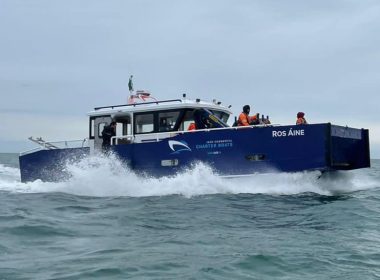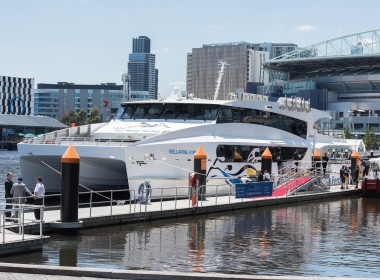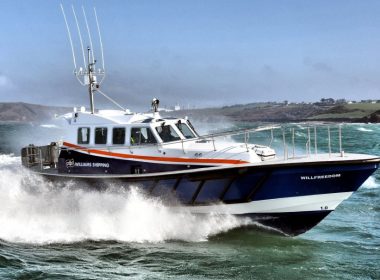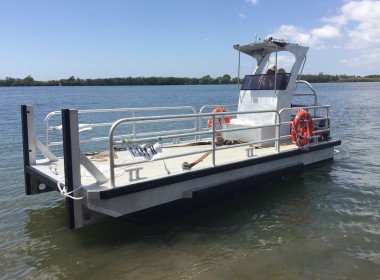AWARDS 2022 | Best Commuter Ferry – Dorado – One2Three Naval Architects & Mavrik Marine

Best Commuter Ferry – Dorado – One2Three Naval Architects & Mavrik Marine
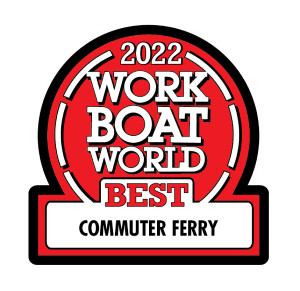
This is the very practical and elegant culmination of a long-distance collaboration between an Australian naval architect and an American builder. The result is a very impressive, safe, and economical aluminium fast catamaran ferry.
As the first of a fleet of four, this vessel will soon become well-known and popular among San Francisco’s Bay Area commuters.
“It is always a challenge coming into a client as a significant fleet owner, and delivering a step change in the vessel that meets the client’s brief,” One2Three told Baird Maritime. “In Dorado’s case, the step change is definitely the fuel consumption, and the low wash that also is a contributor to the fuel savings. Utilising a One2three-customised hull for the vessel was just the start, coupling that with robust weight control across all areas of the vessel and the incredible attention to detail that Mavrik Marine gave during the build in collaboration with the client has delivered an outstanding result.”
The designer added that Mavrik Marine launched the vessel within 200 kilograms of the weight estimate, and the MTU engines and Hamilton waterjets performed exactly to specification, propelling the ferry to 36 knots fully loaded and leaving almost no wake behind.
“The build quality, the streamlined design, the comfort, and most of all, the efficiency are what make the vessel unique,” added Mavrik Marine. “It was purpose-designed to fit in all of WETA’s facilities and handle all of their specific routes, and it is the only vessel WETA has that does that. It does all of this with the least amount of fuel burned by a large margin, just over 35 per cent, over the other vessels in the operator’s fleet.”
For Mavrik Marine, the difficulty in building Dorado was due to outside issues including facility constraints and those related to Covid. The builder said the necessary facilities are now finished and Covid issues have been all but overcome, so the main issue is now expanding the staffing back up to pre-pandemic levels.
“A big part of the lessons learned was the confidence in our process and how important the details are,” added Mavrik Marine. “Things like weight control, accuracy, and quality all lead to an excellent product that will serve the client for years to come. This project cemented those factors for our team. The most important lesson learned on this build was that the front end of these large projects takes twice as long as we anticipate and so we have to do a better job of planning in future projects.”
“We also faced Covid difficulties,” remarked One2Three, “which caused significant supplier delays and difficulties in the schedule. The implementation of EPA Tier IV engines into the build from a weight, space, and maintenance perspective was certainly a challenge. What was originally going to be a power upgrade after the vessel was in service ended up being activated prior to launch. The outcome was still great, but it did not come without some technical challenges along the way.”
For Mavrik Marine, perhaps the most significant trend that will affect future vessels is the move to electrification and zero emissions.
“The electrification aspect has huge implications and hurdles for shoreside infrastructure as well as vessel design,” the builder told Baird Maritime. “Current and future emission restrictions have massive weight-related increases due to the extra equipment needed, not to mention the increased lifecycle and maintenance costs for the client. In order for alternate fuels and electrification to become a reality, the end users will have to compromise with route profiles, carefully manage client expectations, and then get the fuel or power to the vessels by way of large-scale shoreside infrastructure projects. But not every operation will be able to do or afford this.”
“As we exit Covid and the world is getting back to business,” One2Three added, “we see our clients facing challenges around new cost structures, labour shortages, and ongoing supply chain issues, at a time when almost every client is also trying to reduce carbon footprint and embrace alternative green fuels. There is no one solution to fit all operations and shore infrastructure restrictions. At One2three, we are working right now with full electric, hybrid diesel-electric, diesel-hydrogen dual-fuel, hydrogen and methanol fuels, and also harnessing wind, solar, and wave energies (sometimes even all three). Implementing these energy sources and product innovation produces its own challenges in terms of regulation and certification.”
The designer also realised that adopting alternative energy and EPA Tier IV/CARB reduced emissions inherently drive increased waterline length in vessels to enable them to carry the added mass efficiently. An unintended consequence has been an increased difficulty in meeting US Coast Guard tonnage regulations for Category K and Category T vessels. Specifically, the 100-tonne restriction is actively constraining what can be achieved with alternative carbon reducing fuels.
Before Covid-19 came about, One2three’s core business was transport- and tourism-related, but the designer said both were “decimated almost overnight” with the onset of the pandemic. The last three years has therefore seen the company diversify into the military, oceanography, and motoryacht sectors.
“The year 2022 saw a return of the commercial transport sector and 2023 is showing signs of tourism surging,” the designer said. “So business is booming as our traditional markets return and as we continue to engage and win work in the defence, scientific research, and private sectors. We are extremely optimistic about the future, are actively expanding our resource base in response, and embracing innovation and emerging technologies both in alternative energy sources and material science at a record pace.”
For Mavrik Marine, the previous year was one of recovery.
“The prior three years were very difficult with a lot of things affecting various aspects of the business. Covid was tough and the labour shortage has been tricky to work with. All of these things forced us to come up with solutions that will ultimately shape our future in a good way. Fortunately, our facilities are top-notch and our processes keep improving, and now we have a solid orderbook with some exciting projects going forward.”
Mavrik Marine commented that although it is difficult to predict where the boatbuilding industry is headed with all the various pressures at the moment, efficiency in the building process and in vessel design will continue to be important.
“There must be more automation, which requires standardisation, but is almost impossible at the size and range we’re talking about. Then collaboration with our partner yards will be important for resource and project sharing and with regards to scale. We believe weight-conscious, well thought out, and efficient vessels will dominate the industry.”
One2Three meanwhile said that the industry is embracing change, as a new product or a new supplier appears regularly, and multiple products are even proceeding rapidly to market.
“Staying abreast and current with emerging technologies and being able to select, implement, and successfully commercialise an unprecedented level of innovation will shape the way designers and builders work over the next decade. Customised design and a willingness to rapidly adapt to new technology and processes will be paramount, as will entering new partnerships with suppliers. Leveraging established relationships and trust between the design team and the builder will enable technical advancements with reduced risk and minimised cost impact.
The designer also believes that managing emerging technology balanced with cost and selecting the appropriate equipment and processes for each owner’s specific operation will constitute the most important decisions in the coming years.
As for the regional workboat industry, One2Three said the industry will need help to overcome the shoreside infrastructure challenges associated with the transition to carbon-reducing fuels.
“This may involve new partnerships and collaboration in order to share and amortise high costs associated with shore infrastructure,” the designer told Baird Maritime. “Government assistance and ongoing support for innovation by the regulators will also be important. Challenges aside, it will still fundamentally come down to excelling in fulfilling the basics, which are vessels that are well thought out, well-built, and highly efficient.”
“Regionally, offshore survey and support will evolve but generally it will be the charge to reduce emissions that will shape things,” Mavrik Marine added. “With higher capital costs moving forward, it will increase refit and repair costs, but the issue will be compliance by the older vessels and keeping them current, all the while remaining relevant. Conversions will be big, repowers will go beyond new engines and become re-energy solutions, and new construction could be tempered for a short while before building strongly as shoreside infrastructure and energy delivery catches up with demand.”
For a list of the 2022 “Best Of” award winners, please click here.




